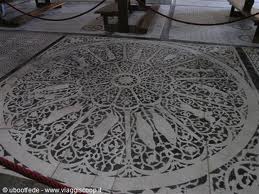While visiting the beautiful romanesque church of San Miniato al Monte you will be fascinated by its location, and while looking at the marvellous ancient pavement, displaying the most remarkable zodiac in Italy, if not in the world, you will read:
"hic valvis ante. celesti numine dante;.mccvii.re
metricus et iudex. hoc fecit condere joseph;.tinent de
ergo rogo cristum.quod semper vivat in ipsum;.tepore mte"
This is written on the marble pavement of San Miniato Church, dating back to 1207. Now observe only the two last words of each line:
"1207. Retinent de tempore et morte" - " these things preserve from time and death".
Which kind of things?
San Miniato is not only a wonderful religious building but it is rich of symbolism. The zodiac is in relationship with the church and its exterior marble façade, like a philosophical machine.
Even the church has been designed and orientated to express the deep relationship between the universe, Christ and the human beeing.
You might say that the zodiac and all astrological ideas are thoroughly pagan, therefore you will be surprised to find a zodiac in a Christian church. Well, this is not the only one in Florence: even in the Baptistry you can see one.
This is probably the expression of the effort to christianize the pagan astrology, but not only....




